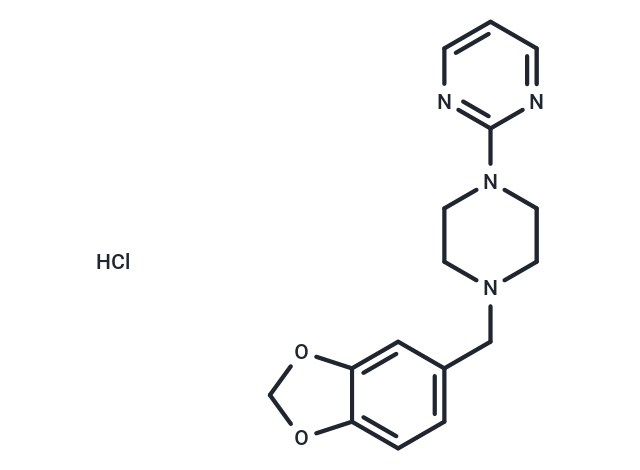Shopping Cart
- Remove All
 Your shopping cart is currently empty
Your shopping cart is currently empty

Piribedil hydrochloride can be used in the parkinson's disease, circulatory disorders, cancers research. Piribedil hydrochloride inhibits MLL1 methyltransferase activity with EC50 value of 0.18 μM. Piribedil hydrochloride is a potent and orally active agonist of dopamine D2 and dopamine D3 as well as the antagonist of α2-adrenoceptors [1] [2] [3] [4].

| Pack Size | Price | Availability | Quantity |
|---|---|---|---|
| 25 mg | $1,520 | 1-2 weeks | |
| 50 mg | $1,980 | 1-2 weeks | |
| 100 mg | $2,500 | 1-2 weeks |
| Description | Piribedil hydrochloride can be used in the parkinson's disease, circulatory disorders, cancers research. Piribedil hydrochloride inhibits MLL1 methyltransferase activity with EC50 value of 0.18 μM. Piribedil hydrochloride is a potent and orally active agonist of dopamine D2 and dopamine D3 as well as the antagonist of α2-adrenoceptors [1] [2] [3] [4]. |
| In vitro | Piribedil hydrochloride, at concentrations ranging from 0 to 160 μM over 7 days, specifically targets and inhibits MLL1 methyltransferase activity while also selectively suppressing the proliferation of MLL-r cells, as indicated by cell proliferation assays on MLL-r AML cells (THP-1 and MV4;11) and a non-MLL leukemia cell line (K562). This compound, over a 4-day period at the same concentrations, not only selectively reduces H3K4 methylation in MLL-r cells by disrupting the MLL1-WDR5 interaction but also prompts cell-cycle arrest, apoptosis, and differentiation in these cells. Western blot analysis further reveals a concentration-dependent decrease in H3K4me2 and H3K4me3 levels, without affecting other histone methylation sites such as H3K79, H3K36, and H3K27, showcasing its selectivity and potential therapeutic implications in treating MLL-r leukemia. |
| In vivo | Piribedil hydrochloride, administered through intraperitoneal injection at doses of 5, 15, and 40 mg/kg, effectively mitigates L-DOPA-induced dyskinesias in a rat model of Parkinson’s disease. When given orally at a dosage of 4-5 mg/kg daily for two weeks, it enhances locomotor activity and reverses motor deficits in adult common marmosets. Additionally, a higher concentration of 150 mg/kg administered daily for 21 days via oral gavage has been shown to inhibit MLL-r tumor growth and reduce expression levels of MLL1 target genes in MV4;11 tumor xenografts. Studies revealed a reduction in turning behavior and various forms of dyskinesia in rats, with an increase in locomotive dyskinesias observed at the 40 mg/kg dosage. In marmosets, there was an increase in vigilance and alertness along with the reversal of downregulated preprotachykinin mRNA in the striatum, indicating improvements in motor and neurological functions. |
| Molecular Weight | 334.8 |
| Formula | C16H19ClN4O2 |
| Cas No. | 78213-63-5 |
| Storage | Shipping with blue ice. |

Copyright © 2015-2025 TargetMol Chemicals Inc. All Rights Reserved.